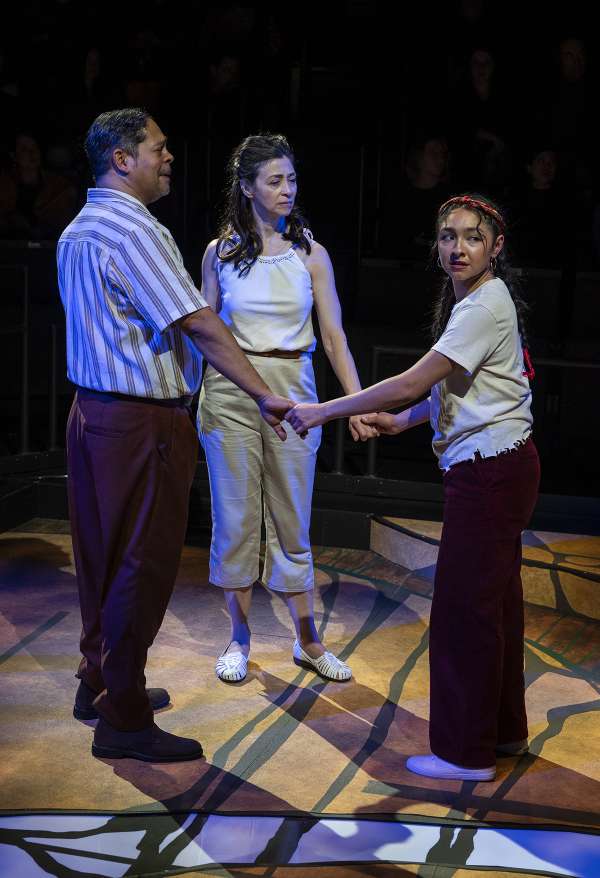Your Chicago Guide’s tickets for two to the the press viewing of a home what howls courtesy of Steppenwolf for Young Adults.

A coyote howling. A home in disarray. A young woman alone. In Matthew Paul Olmos’ world premiere of a home what howls (or the house what was ravine), Soledad Vargas is in the city, fighting for her family’s right to live on their land. When hope starts to dwindle, how far will she go, and what will she be forced to leave behind? A modern myth drawn from the real life struggles of displaced communities around the globe, a home what howls is a lyrically-rendered quest of youth activism standing against forces of injustice.

Though the play itself is fiction, its roots are deeply entrenched in history and reality. a home what howls is inspired by the true story of “The Battle of Chavez Ravine” – a community displaced, a citywide intention for integrated public housing, and the lasting impacts of a stadium built on a land where once there was a thriving community. While a home what howls shows us one family, in one place, at one time, what happened in Chavez Ravine echoes in many parts of our country’s history.

The Battle of Chavez Ravine refers to resistance to the government acquisition of land largely owned by Mexican-Americans in Los Angeles’ Chavez Ravine. The efforts to repossess the land, which lasted approximately ten years, eventually resulted in the removal of the entire population of Chavez Ravine from land on which Dodger Stadium was constructed. The majority of the Chavez Ravine land was initially acquired by eminent domain by the City of Los Angeles to make way for proposed public housing.

This public housing plan that had been advanced as politically progressive, and had resulted in the removal of the Mexican-American landowners of Chavez Ravine, was abandoned after the passage of a public referendum prohibiting the original proposal, and the election of a conservative Los Angeles mayor opposed to public housing. By 1958, the public housing plans were abandoned and the land was conveyed by the city to the Dodgers. The new plans were advanced to construct Dodger Stadium on the site, and in 1959, the Los Angeles County Sheriff’s Department forcefully removed the last residents occupying Chavez Ravine.

“I think of nature, hills, a nice neighborhood where everyone knew each other. The streets were lined with palm tree’s. The area [Chavez Ravine] in my point of view, was like the Garden of Eden” – Frank Costello, former Chavez Ravine resident.
Named after Julian Chavez, one of the first Los Angeles County Supervisors, Chavez Ravine was a tight knit community where people grew their own food, ran their own schools and churches, and had their own thriving businesses . The area known as Chavez Ravine comprised three primarily Mexican-American neighborhoods; Palo Verde, La Loma, and Bishop. The area spanned 300 acres of land and was a home for more than 1,100 families.

In a home what howls, Olmos draws on this history through his creation of the characters Abrana and Manuel Vargas, Soledad’s parents. We learn early in the story that they are afraid to leave their home – despite the sounds of tractors and machinery that are clearly getting closer. Not only do they wish to stay on the land that has always been home, but they also fear that leaving could prevent Soledad from finding them again. While Manuel and Abrana remain in the home, they lean on Soledad to fight the planned displacement of their community. They trust that if they just hold on a little longer, she will save them.

“…Yea, this whole expanse is going to have the nicest shops, sundries, soda fountains, you name it. You can already see the lots marked off. Which makes me wonder what you two were expecting to find. Anyone who lives around here, knows they got to get off at a previous station if they want to… these lots right here, are for future residents only.” — Male Conductor.

The story of Chavez Ravine isn’t an isolated case. History tells countless stories of communities displaced with the initial intention of public housing, and then eventually for a different public purpose entirely – much as Male Conductor describes in a home what howls. Bringing the Dodgers to LA and building a stadium in Chavez Ravine changes the kind of populations, who end up living in the area. Often, in cases like this, it leads to gentrification.

In a home what howls, Soledad Vargas views herself as an advocate in her community. She speaks up for those in need and she has learned that when her words fail her, that might be a moment to try other tactics. However, every community is different, and we all have our own roles that we embody within them. Steppenwolf for Young Adults brings a home what howls to life for young people everywhere. It is an example of aspiring youth activism fighting against injustice. There is something to be gleaned from the play for all of us.
a home what howls (or the house what was ravine) is now on stage at the Steppenwolf’s Ensemble Theatre, 1646 North Halsted, in Chicago’s Clybourn Corridor neighborhood.
